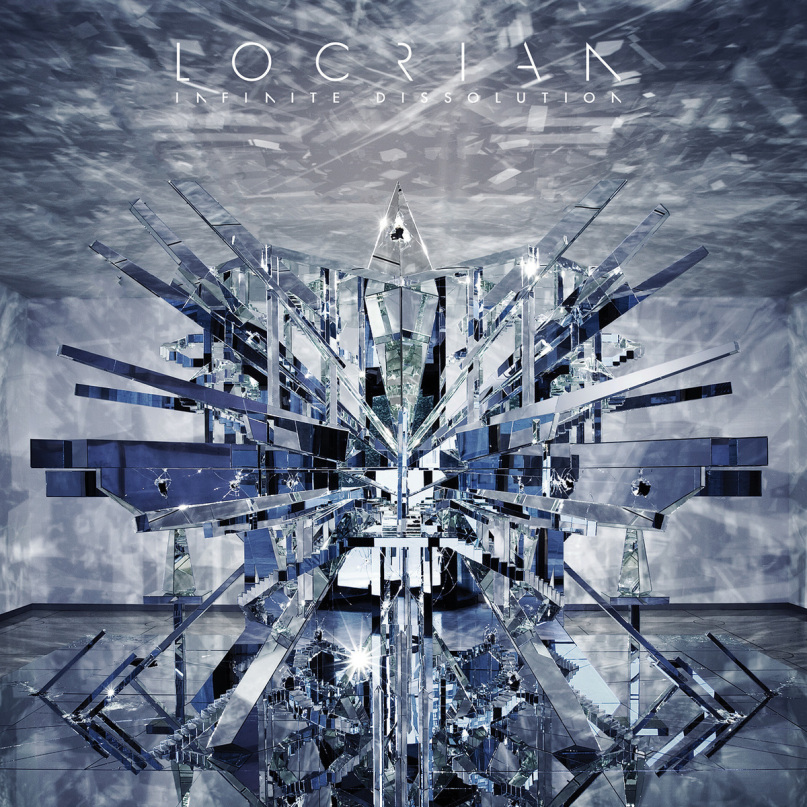Before hearing a single second of Infinite Dissolution, Locrian’s incoming full-length and their second proper for Relapse, the record’s striking cover art hints at the aesthetic permutations of a band that is no stranger to rigorous experimentation. The repurposed image of David Altmejd’s 2008 work ‘The Eye’ renders the sculpture colossal, unnerving – an architecture of myriad surfaces and impossible angles that is both imposing and unnervingly alien. For a group who have, even during their most ecstatic moments, so intently peered into the subterranean void (visually evinced in the queasy landscapes of past releases like The Crystal World and Territories), it’s a sign that their gaze has shifted skywards, to an emphatically more celestial one.
That’s not to say Locrian have become less dour – Infinite Dissolution is, they state, a concept record about the ‘inevitability of extinction’, a sentiment that runs throughout the spare, hopeless lyrics – but the record’s crystalline textures and dizzying sonic nuances are here dragged from smothering darkness into brilliant light. It’s an excellent record, even if this shift arrives at the expense of certain aspects of their sound – the sprawling slow-builds and claustrophobic grimness – that has made them such a vital underground force for over a decade.
The Baltimore/Chicago three piece was formed by guitarist/multi-instrumentalist Andre Foisy and keyboardist/vocalist Terence Hannum in 2005 – drummer Steven Hess made his first appearance in 2010. They’ve always been more of a tonal noise/drone band than the black metal one they’re often pinned as; that latter element manifesting itself most effectively as measured releases from the Swans-esque tension building and power electronics workouts that managed to be both harrowing and electrifying in their compositional detail. (And, unlike the head-razing BM/noise work of bands like Wold and Vegas Martyrs, frequently beautiful).
With Infinite Dissolution they build on the framework of 2013’s Return To Annihilation, successfully melding those genres with prog, industrial and post-rock into a consistent and muscular whole (helped in no small part by Greg Norman’s sterling production job). It’s a work that, while being their most accessible to date, is still dense enough to reward patience and repeated listens.
Opener ‘Arc Of Extinction’ immediately lurches into a solid three minutes of noise, the guitar and synth merging as a refulgent wall of distortion undercut by Hess’ spare, martial tom thuds. Hannum’s eventual harrowed shrieking sounds as distant as ever (as if recorded from the opposite end of a chasmic oubliette); a brief precursor to the sudden tip into furious blasting, a simplistic descending chord structure and a harmonic lead spiralling off overhead. It’s the most conventional black metal moment on the record, and one of its most thrilling.
‘Dark Shales’ is initially closer in sound to the 2011 cover of Popol Vuh’s ‘Dort Ist Der Weg’ before seguing in to a melodic five minutes of Cascadian-tinted post-rock; while ‘KXL I”s industrial shower and seething banks of sheet noise comprise Infinite Dissolution’s most abject arc, an aesthetic emphasised by the near-poppyness of the track immediately proceeding it.
I was slightly taken aback by ‘The Future Of Death’ on first listens, with its mix of simplistic coldwave synths and a middle section not a million miles away from the cosmic post-hardcore of At The Drive In. Along with Erica Burgner-Hannum’s jarring guest vocals in the closing passages of ‘An Index Of Air’, it’s the album’s only near misstep, a track uncomfortably close to conventional given Locrian’s conceptual nous (albeit one that that I find myself warming to with each subsequent listen).
The forlorn string loop of ‘KXL II’ – wavering over a heady static crackle – is highly affecting for a glorified interlude, making way for the pensive fuzz of ‘The Great Dying’ and the eventual album peak of ‘Heavy Water’. The latter builds on a glacial, oscillating wash of synth, overlaying a clean, circular guitar figure and more of Hannum’s haunted shrieking. There’s not much more to it – an insistent kick drum leading to a peak of modest volume before letting the track fade into itself again – but it’s gorgeous, haunting stuff, further evoking a freezing astral plane in place of the sodden netherworld and urban wastelands that Locrian have inhabited until now. It’s a lonely, exhilarating place to be.
<div class="fb-comments" data-href="http://thequietus.com/articles/18378-locrian-infinite-dissolution-review” data-width="550">


